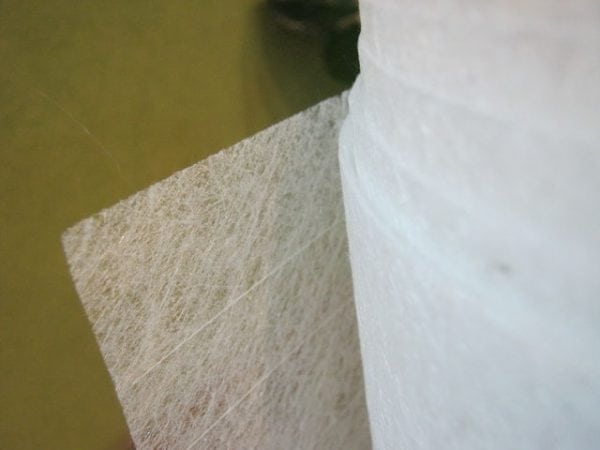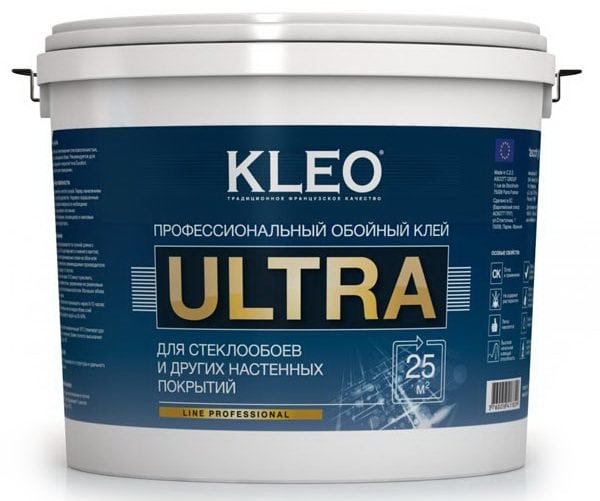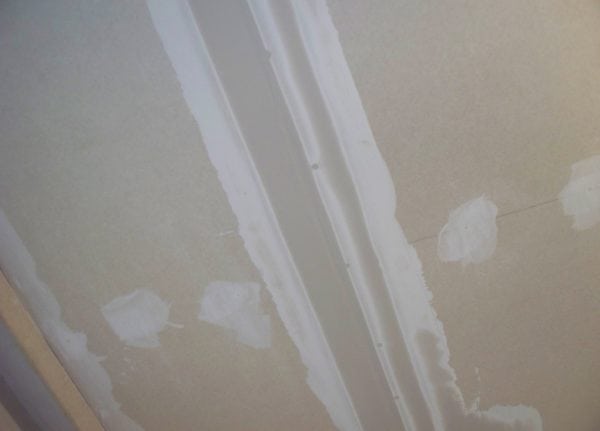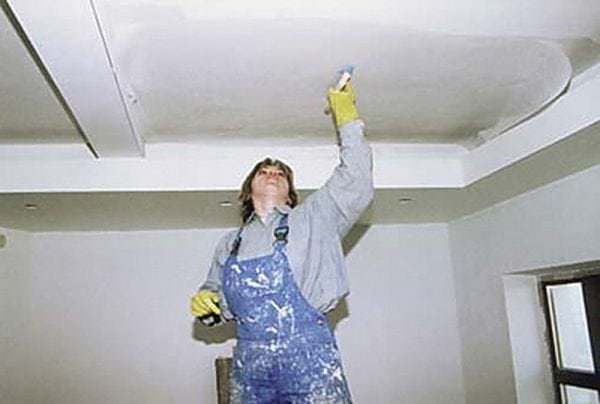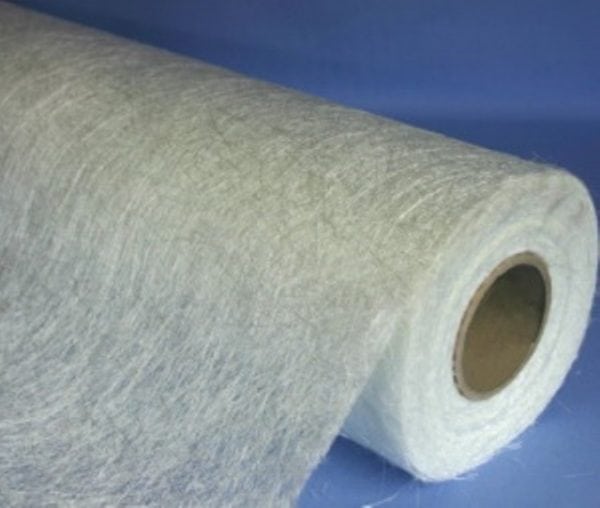Many builders have encountered a situation where cracks appear along the seams on the drywall surface. At the same time, the serpentine net does not always help out from cracking, because it can arise under the influence of such powerful forces as shrinkage of the building or sharp temperature drops.
- Recommendations for choosing fiberglass
- Application technology
- Preparatory stage
- Installation work
- Puttying
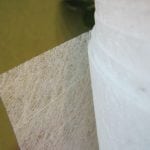
To avoid the consequences of such cases, fiberglass (colloquial name - "spider line") is used, which is a fiberglass. However, these are not interwoven yarns, as is the case with cullets, but non-woven material produced by pressing. This material is able to thoroughly harden the surface and minimize the risk of cracking.
To improve the performance of fiberglass, it is recommended to putty it. The features of the use of this protective material and how to prepare fiberglass for putty will be discussed in this article.
to contents ↑Recommendations for choosing fiberglass
Fiberglass is highly resistant to all kinds of environmental factors: moisture, fire, chemicals, mechanical stress. Material properties are maintained for many years.
The optimal level of density of the material should be 45-55 grams per square meter. Fiberglass is offered in 50 meter rolls of meter wide. If you wish, you can agree with the seller on the purchase of only part of the roll.
To stick the canvas, you will need the same special adhesive as for glass. In any case, this should be very high quality adhesive, since the strength of the entire structure depends on it. It should be noted that the consumption of glue when fixing the cobwebs for puttying is fifty percent higher than when gluing glass wallpapers. The increased consumption of glue is associated with the features of fiberglass - it easily absorbs the adhesive.
You will also need a special tool for installation work: a smoothing spatula and a construction knife. Using a spatula, we will smooth the surface and squeeze out air from under the coating. We will cut off excess material with a knife.
to contents ↑Application technology
To perform work without marriage and not to start all over again, you must adhere to all technological standards. Although the work cannot be called simple, it is quite possible to do it yourself.
Preparatory stage
Preparatory activities are carried out in the following order:
- We determine the sizes of all surfaces on which fiberglass will be glued. As a result of the measurements, we determine the required amount of material. A certain supply of material should be provided (within 5-10%), since the material is glued with an overlap. Also, do not forget about the increased consumption of glue, as mentioned above.
- The canvas is not glued directly on drywall, but on a putty surface. First, putty the joints and places where the fasteners are (we use a mesh-sickle). Next, putty on the main surface. The dried coating is ground with an abrasive until the surface becomes smooth.
- You should also inspect the surface for defects (chips, cracks, etc.). If any, fill them with putty.
- Before gluing fiberglass, the base should be cleaned of dust and dirt.To do this, you can use a slightly damp sponge and a vacuum cleaner. It is recommended to remove contaminants immediately before gluing so that dust does not accumulate again.
Installation work
Below is an instruction for gluing fiberglass:
- Cut off a piece of the sheet of the desired length. It should be noted that for the wall you can use full-sized sheets, but for working with the ceiling a two-meter sheet will be more than enough, otherwise there will be difficulties during its installation.
- Prepare the glue. It is important to adhere to all the requirements of the manufacturer. If you violate the cooking technology, for example, the consistency will be too thick or liquid, the working process will be very difficult. You can not waste time preparing an adhesive solution, but to get a finished composition - this will greatly simplify the work. However, the cost of the finished glue is much higher than the concentrate.
- Do not forget about your own safety. If particles of fiberglass get on the skin, the sensations will not be pleasant, because we are talking about glass. If particles get into the nose, a prolonged sneezing is inevitable. Therefore, it is recommended to wear a respirator, goggles, rubber gloves and coarse cloth with long sleeves before starting work. It should be noted that particles should be feared only during installation. After gluing, the particles will settle and will not be dangerous.
- Glue will be applied using a brush-mackle. The glue should be sufficiently viscous, so a regular brush or paint roller is not the best choice in terms of ease of use. In addition, the maklovitsa allows you to apply a thick layer to the surface, because (as we noted earlier) fiberglass absorbs glue well. It is recommended to pre-spread not the entire wall, but specific areas where sheets are immediately glued.
- Glue the first sheet from the corner of the structure. The gluing technology is simple: we apply a sheet to the adhesive layer applied to the wall, gently press it down and level the surface with our hands. Then, using a smoothing spatula, we remove air and excess glue from under the sheet.
- After the sheet has been leveled, we cut off excess fragments from it. We also cut the overlaps on the skirting boards and, if necessary, in other areas. For cutting we use a construction knife.
- The next step is the glue treatment of the outer surface of the glued fiberglass. Particular attention should be paid to the impregnation of the entire surface area (dry areas should not remain), since otherwise it will not be possible to ensure reliable adhesion. There is a very simple sign that allows you to make sure that the canvas is properly impregnated - it becomes much darker in places where the glue is applied.
- A sheet of fiberglass is glued slightly overlapping. First, the sheet needs to be leveled by removing air from under it, and then make a cut directly in the overlap. Next, cut off the excess parts of the canvas and get a seam that is visible externally, but not felt by palpation. Thus, we get a perfectly smooth surface.
Note! Cut material at the inside and outside corners. The fact is that the fiberglass will tear in these places without cutting, but in this case the separation line will be uneven.
One more circumstance should be mentioned: the seams between the sheets should not coincide with the drywall joints. If this rule is violated, fiberglass will definitely crack in this area. It is recommended to remember where the sheets are fixed and where the joints are in order to avoid alignment.
The surface will dry for about 24 hours. At this time, all windows and windows should be closed. There should be no drafts in the room. After drying, you can continue finishing work.
to contents ↑Advice! The "spider web" has a front and wrong side. If you have experience, you can decide on the side at a glance. However, if any difficulties arise, there is a label on the roll with the sides indicated. Rolls are most often folded so that the inside is inside out.
Puttying
The need for puttying is dictated by the following circumstances:
- It has already been said above that the absorbency of fiberglass is impressive, and it applies not only to glue, but also to other liquids. If you leave the surface unplated, the absorption of paint will be very large in the future. Will have to apply 4-6 layers of paint and varnish material, which will lead to serious costs.
- Glass canvas has a peculiar texture that does not look very attractive. Paint will not hide this texture, but it will perfectly mask the fiberglass putty.
- If wallpapering is to be done, putty cannot be dispensed with, since otherwise peeling of the material is inevitable.
Puttying is carried out in the following order:
- Apply a layer of primer to the surface. This will reduce the absorption of the material and improve adhesion.
- First, apply the first layer of putty. Let the coating dry (depending on the type of putty, this may take up to a day).
- Apply a second layer of putty. After it dries, we grind the surface with a grater and sandpaper. The plane is checked by an electric lamp.
- The last stage of the work consists in painting the surface or gluing wallpaper. Also, fiberglass can be treated with decorative plaster.
So, the use of fiberglass is fully justified in terms of increasing the reliability of the entire structure. Also can not do without puttying. This operation is carried out in the same way as the filling of any other surface.

